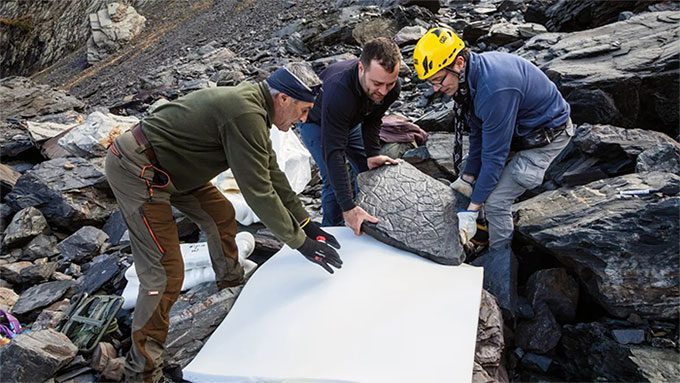A Chance Discovery by an Italian Woman Leads Scientists to Uncover a Pre-Dinosaur Ecosystem.
“The Lost World” was discovered by an Italian woman named Claudia Steffensen. While hiking with her husband in the Valtellina Orobie Mountains Park in Lombardy, Italy, part of the Alps region, she stepped on a rock that looked like a slab of concrete.
“Then I noticed strange circular designs with wavy lines. I looked closer and realized it was a footprint,” Steffensen shared with The Guardian.

A fossil slab from the “Lost World” placed on specialized white foam material before being transported to the laboratory – (Photo: Elio Della Ferrera).
Scientists approached the site and analyzed what was named “Rock Number 0”, confirming that it bore the footprints of a prehistoric reptile.
This prompted them to ask: What else might be in this area?
Subsequent excavations revealed that the fortunate Italian woman did not merely find a rock; she had opened the door to an entire lost world, older than the age of dinosaurs.
This was a tropical lakeside ecosystem, featuring diverse fossil specimens dating back approximately 280 million years, placing them in the Permian period.
According to Live Science, the traces of this ecosystem include fossilized footprints from various reptiles, amphibians, insects, and arthropods.
Additionally, researchers discovered ancient traces of seeds, leaves, and tree trunks, even remnants of raindrops and waves lapping at the shore of an ancient lake.
This ancient ecosystem spans elevations up to 3,000 meters, both in the mountains and at the valley floor, where landslides have deposited rocks containing fossils across many ages.
Preserved in fine sandstone, these specimens from the lost world are incredibly well-preserved, representing an extraordinarily rich paleobiological treasure.
According to paleontologist Ausonio Ronchi from the University of Pavia (Italy), they even found slabs still imprinted with claw marks and patterns from the undersides of at least five different animal species.
“At that time, dinosaurs did not yet exist, but the animals leaving the largest footprints found here must have been quite large,” added paleontologist Cristiano Dal Sasso from the Natural History Museum of Milan.
Importantly, the fossils from the Permian period are invaluable.
This is because approximately 250 million years ago, when the Permian period ended and was succeeded by the Triassic period, Earth experienced one of the worst mass extinctions in history, wiping out 90% of existing species.
The discovery in Italy provides one of the rare windows for humanity to understand this still mysterious ancient world.




















































